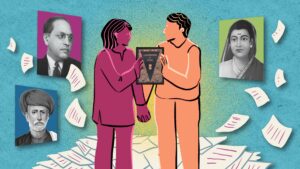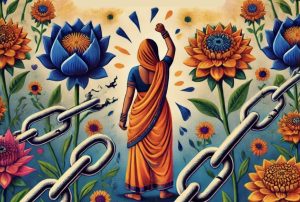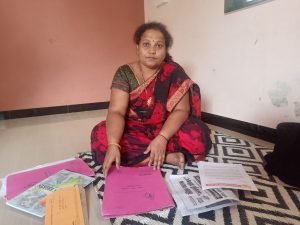It is crucial to understand that this festival is not accepted or celebrated by other communities in the city. “Upper castes think that we are untouchables, so our festivals should also be treated like they treat us,” says Raghu, 30.
Khare points to the caste dynamics at play during the festival. “Although the so-called upper castes do not celebrate this festival, honoured guests called to witness the chhadi competition are usually from rich, upper-castes. Their presence is not to show their love [for the community’s traditions] but display their place in the caste hierarchy,” he says.
Unlike the celebrations around Jaharveer’s birth, most festivals of the dominant community revolve around the destruction or death of subaltern deities or figures in mythologies: Holi, for instance, is celebrated as the killing of a Bahujan woman, central to Ram Navmi is the killing of Shambuka, a shudra, and Durga Puja marks the killing of an indigenous king.
Academic and writer Kancha Illaiah has discussed the nature of the relationship between Dalits and their regional deities. “Our relationship with our deities was transactional and rooted in the production process,” he says. Hence, the prayers to Jaharveer are all about birth, health and safety; they do not seek salvation, wealth or prosperity, as is the norm in dominant cultures.
Khare reiterates this point: “Salvation is desired by those who have all [material] facilities in life, here there are none. There is scorn, there is ostracism, in the midst of all of this, this fair is [an expression] of joy.”
The Valmikis of Mathura seek Gogaji’s protection against disease, perils and childlessness. Women pray for a male child, others for protection from disease, natural perils and failure.
“Gogaji protects us from snakes; whenever any snake is found at home or in farm fields, we worship Goga ji, then they don’t harm us,” says Rahul Kashyap, 38. “He fought wars for us; in return, we have given him a special place in our lives.”
The folk deities of Dalits are human, of human nature; they are not transcendental. They are not there to establish their power but to reduce their burden by participating in their sorrows. The gods of the privileged castes, on the other hand, are perceived as figures of power and dominance.
In his work, Cultural Expressions of Dalits, SA Samy states: “The upper caste oppressors saw to it that the Dalits would never produce a culture of their own. The others ingeniously used the art form and the various traits of their culture to oppress and dehumanise the Dalits…The contemporary upsurge of Dalits in Indian cultural and political mainstream, therefore, not only challenges the existing historical and sociopolitical scholarship on South Asia but also tries to provide new epistemological alternatives by bringing the ideas and articulations from the margins to the core in rewriting history.”
Dalits must retrieve and revive old and new faith-based systems to maintain their humanity and self-respect. By erasing these, we deny them the means to do so.
Babasaheb Ambedkar says: “In Hinduism, one [cannot] have freedom of expression. A Hindu must sacrifice his freedom of expression. He should act according to the Vedas. If the Vedas do not support the actions, instructions should be sought from the Smritis, and if the Smritis fail to give any such instruction, they should follow in the footsteps of the great men. He should not argue. So, as long as you are in Hinduism, you cannot expect freedom of thought.”
[This story is edited by Jahnavi Uppuleti and Malini Nair.]





